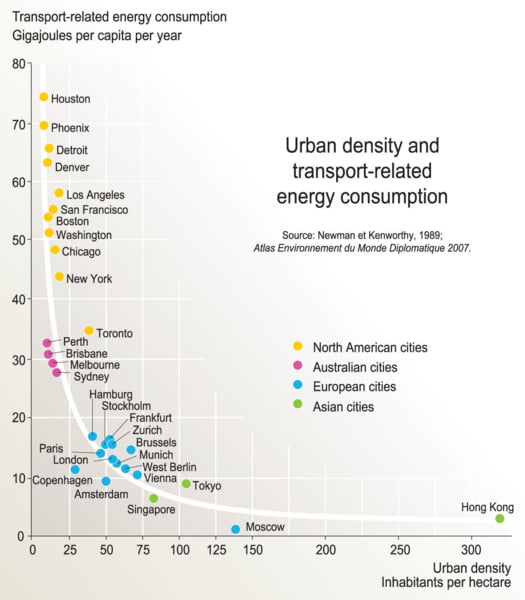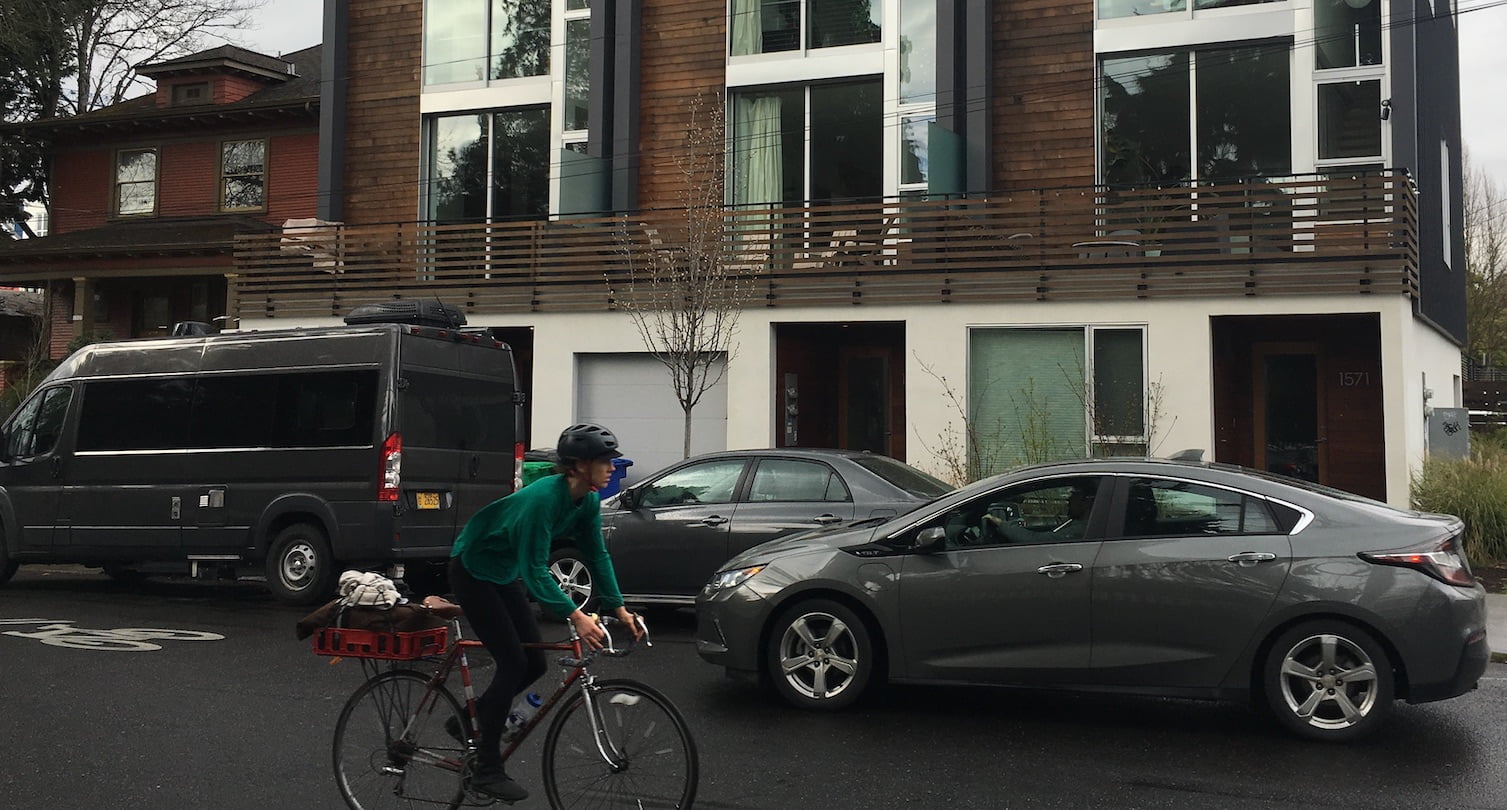Buildings don’t move, so what do they have to do with transportation? Plenty. While green building designers, builders, and developers have little say when it comes to zoning, highway and street development, transit routes, or street connectivity; they have good reason to care about transportation. And they have a significant role to play in increasing transportation efficiency.
Green building professionals should think about transportation because 69% of all greenhouse gases in the US are caused by the combination of buildings and transportation –40% and 29% respectively. For large office buildings, the energy used for all employees to travel to and from the building, can be greater than the energy used to operate the building itself. This outsize example of the building/transportation interface on greenhouse gas emissions is due largely to urban sprawl and how we locate and use our buildings.
Urban Sprawl
The expanse of land taken up by urban areas has grown much faster than the growth of the population within them. For example, urbanized land area increased 2.5 times faster than population growth between 1950 and 2010. The result has been the growth of urban sprawl with a correspondingly inefficient transportation system. To boot, transportation planning has often made sprawl worse because it has largely been about adding more capacity in the form of wider roadways and more parking. It’s well documented that demand simply grows to fill, and then exceed, the new capacity. Adding road capacity seems to instantly increase the miles traveled for shorter, daily trips.
Perhaps a bigger issue is the fact that more road capacity has the long-term effect of promoting far-flung development and urban sprawl. Time is a key factor here. As travel speeds increase, people are willing to go further to work, to shop, or to access services.
But it’s not just about the supply of roads. There’s a demand side, too, and that’s where buildings come in. Buildings are the destinations of daily travel, and their locations have a tremendous effect on the number of miles people travel each day to reach their workplaces, schools, shopping, entertainment, and more.
Urban Sprawl and Transport-Related Energy Consumption
In 2015, vehicles drove more than 3 trillion miles on roads in the US. Vehicle miles traveled (VMT) is a basic transportation statistic that expresses the amount of vehicle traffic occurring in a given geographic area and is directly correlated to fossil fuel consumption and greenhouse gas emissions. While the US population doubled from 1950 to 2010, VMT increased six fold, in part due to urban sprawl. So, sprawling cities use much more energy for transportation than more dense, urban areas.

Source: Center for Sustainable Systems, University of Michigan
This graph shows the relationship between the amount of energy used for transportation and the population density of a city. It serves as a useful illustration of the idea that more compact urban areas will reduce the amount of energy used for transportation and reduce the amount of greenhouse gas emissions from this sector.
Making cities more compact means putting more people into smaller areas. At first glance, this may not seem like a good idea and is certainly contrary to the way that North American cities have evolved. But livability will not necessarily suffer from greater population density. In fact, the opposite may be true. Thoughtful design of urban spaces and the buildings within them has many benefits including improved quality of life and happiness for residents.
Some negative effects of high urban density include crowding, lack of privacy, lack of access to nature, air pollution, noise, etc. Careful green design can reduce or eliminate all of these factors. Because humans are social animals, higher density has many advantages. These include more employment choices and greater social ties, along with better access to high quality information, food, health care, and entertainment. In contrast, those living in rural areas with low population density tend to be older, poorer and less healthy than urban dwellers.
High density alone is not necessarily a negative. The role of well thought out green design at all levels – from buildings to neighborhoods to cities – is to promote the advantages of urban living while addressing the disadvantages.
How Green Building Principles Foster Green Transportation
While the relationship between urban sprawl and miles traveled per person is real, population density is not the only factor that explains the explosive per capita growth in travel. And as a result there are many green building principles that builders, developers, and planners can use to help reduce high per capita vehicle miles traveled and transport-related greenhouse gas emissions.
Utilize Infill Sites
While the greener pastures of urban fringes attract many developers and contribute to sprawl, there are many opportunities within cities too. Small infill lots and larger “greyfield” sites with abandoned buildings generally have good access to urban infrastructure. As shopping centers and malls age and wither, they can be redeveloped into housing. The big advantage to these sites is their close proximity to urban centers, ample infrastructure, and relatively low real estate costs. “Brownfield” sites that previously hosted industry offer opportunity, too, but there are often costs associated with demolition and decontamination of these abandoned industrial sites. Taken together, a variety of infill opportunities exist for those willing to accept the design challenges.
Work/Live/Play Planned Communities
One reason for high VMT values is the ill-conceived, 20th century notion that commercial and residential zones should be segregated. Traveling from home to work everyday consumes time and energy while creating pollution. Mixing residential and commercial uses into the same neighborhoods and even the same residential/commercial buildings can reduce the distance many people need to travel.
Locating green buildings in walkable and bikeable neighborhoods, close to work, medical and other services, shopping, and schools will help reduce per capita transportation by reducing a family’s traveling needs. These mixed-use developments can be planned to be work/live/play communities that include major employers, shopping, services, outdoor recreation, entertainment, natural areas, and schools – all within walking or biking distance.
Access to Transit
New buildings should be located near transit corridors. The distance from the nearest transit stop should be no more than one-half mile. People living or working near transit are 2.5 times more likely to use it. Transit-oriented development is one way to make housing more affordable by reducing or eliminating the need for auto ownership.
Inviting Streetscapes
Each building’s streetscape should be safe and inviting. This means ample room for walkers and safe pathways for bicycles and other wheeled conveyances. Buildings should offer easy connections to street level walkways in all directions. It’s clear that getting people out of cars is good for small businesses along these routes. Adding vegetation and pocket parks cools the street, provides contact with nature, reduces pollutant concentrations, and encourages people to use their feet instead of a car.
Unparking
Some urban design standards still require large parking lots between the sidewalk and building entrances. More forward thinking cities are turning the idea around, pushing storefronts closer to sidewalks so they are more convenient to pedestrians and cyclists. While most people think a parking problem is not enough parking spaces, the opposite may be true. Many cities are reducing or eliminating minimum parking requirements, especially near public transit, to allow less distance between buildings and to encourage a reduction in motor vehicle traffic. Ride sharing, car sharing, and bike sharing services can greatly reduce the need for parking. In well-designed live/work/play communities, much less parking will be required as most residents can safely walk or bike to nearby stores, schools, or workplaces.
Building Form
Human scale is important. Few people find it comfortable in deep, dark concrete canyons. Urban and building design must allow sunlight to reach street level and air to circulate. Smaller cities might find a mix of building heights to be beneficial along with ample use of terraces and rooftop spaces. Rooftops should be considered valuable space for people and not just a place to hide mechanical equipment.
Compactness for Housing and Commerce
Small homes and apartments are less expensive to build, consume less energy to operate, and take up less space. It’s logical that high-density development benefits from compact homes, apartments, and businesses. Well-designed common spaces and amenities inside buildings along with accessible green spaces and public areas outside, such as restaurants and services, more than compensate for smaller living spaces and promote physical activity and social interaction.
Support Multi-modal Transportation
Every building is a destination for travellers. To encourage travelers to use bicycles, scooters, and their electric versions, buildings should have facilities to support them. Secure bike storage for employees takes up far less space than what is needed to park a car, SUV, or light truck. These can be individual lockers or shared bike cages. Bike riders also need access to showers and changing rooms.
Bike ownership is not necessary for daily commuting. There are many bike share programs that charge a small monthly fee for access to a fleet of bikes stationed around a city. Building developers can support bike sharing by offering a bike share station in or near the building.
Electric bikes are growing in popularity and make cycle commuting more attractive to more people. They require standard 110-volt electric outlets for charging, which green builders and developers can easily incorporate in their designs.
Electric Vehicles
While the main goal of transportation-aware green design is to reduce the need for traveling long distances in single-occupancy vehicles, it would be naive to think that a century of human habit can be changed overnight. When privately-owned cars are to be used, they should be powered by clean, renewable electricity. One big advantage that electric vehicles offer building developers is that they produce no toxic exhaust. An enclosed parking facility would have much lower ventilation requirements if it were designed exclusively for electric vehicles, and it would be a great service to employees if parking areas were fitted with charging stations. In fact, all green commercial buildings should be designed to provide fast chargers for employees and visitors, helping to reduce greenhouse gas emissions from commuting. Wherever possible, green buildings – both residential and commercial – should be designed not only to include EV charger hookups, but also to be powered by on-site renewable energy generation to reduce greenhouse gas emissions.
And don’t forget commercial electric vehicles. In the near future, delivery and maintenance vehicles will need charging, too. If every destination building offered a charging as a service, buildings could further enhance the efficiency of commercial transportation.
Designing for Efficient Transportation
No building is an island. Each one is a destination at the end of a trip. The distance between destinations and the facilities available there can either promote or discourage efficient travel. The benefits of thoughtful multi-mode transportation integration and the provision for EV infrastructure are fewer carbon emissions, less pollution, fewer respiratory illnesses, cooler cities, and better overall health. Every builder, designer, and developer should make sure their green buildings become a positive and effective node in the community’s transportation network in order to help reduce the per capita vehicle miles traveled and reduce transportation-related greenhouse gas emissions.

